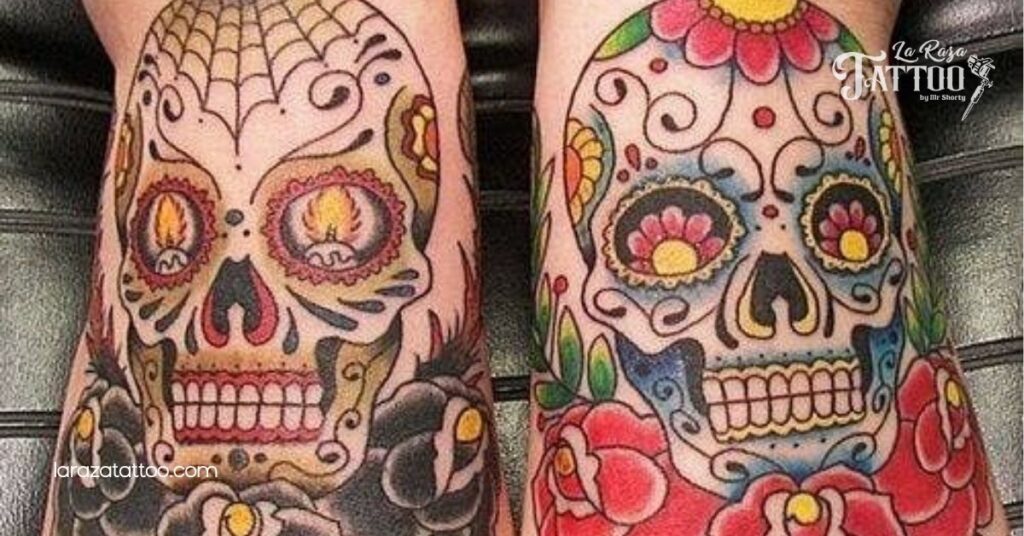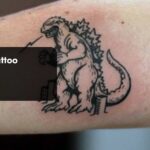If you’re looking for a tattoo that combines artistry with deep cultural significance, the Day of Death tattoo might just be what you need. Celebrating life and honoring the memories of loved ones, this vibrant design captures the essence of the Mexican Día de los Muertos tradition. It’s more than just ink on skin; it’s a powerful statement about life, death, and everything in between.
Imagine wearing a piece of art that not only reflects your personality but also tells a story of remembrance and celebration. With intricate designs featuring sugar skulls, marigolds, and colorful motifs, a Day of Death tattoo can be a stunning tribute to those who’ve passed while embracing the beauty of life. Ready to explore this meaningful tattoo choice? Let’s jump into the industry of Day of Death tattoos and discover why they resonate with so many.
Understanding Day Of Death Tattoo

Day of Death tattoos celebrate life while honoring the memories of loved ones. These vibrant designs connect deeply with an important cultural tradition.
Meaning Behind Day Of Death Tattoo
Each Day of Death tattoo tells a story. Sugar skulls symbolize the cycle of life and death, often featuring colorful decorations that reflect a celebration of life rather than mourning. Marigolds, also prominent in many designs, represent the beauty of life and serve as a pathway for spirits to return. You might notice these tattoos include names or dates, further personalizing the tribute. Remembering loved ones through this expressive medium allows individuals to keep their memories alive.
Cultural Significance Of Day Of Death Tattoo
These tattoos are rooted in the rich tradition of Día de los Muertos. Originating in Mexico, this celebration honors ancestors and embraces mortality in a joyful way. Many people see Day of Death tattoos not only as art but also as a way to reconnect with their heritage. They’ve gained global popularity, showcasing the fusion of different artistic styles and cultural motifs. By wearing these tattoos, you participate in a broader dialogue about life, death, and remembrance that transcends boundaries.
Popular Symbols In Day Of Death Tattoo
Day of Death tattoos are adorned with vibrant symbols that carry deep meanings. Here are some of the most beloved symbols within this tradition.
Sugar Skulls And Their Importance

Sugar skulls, known as calaveras, take center stage in Day of Death tattoos. These colorful designs embody the sweetness of life and the joy brought by those who have passed. They serve as a beautiful reminder of the love and memories shared with departed loved ones. Intricately detailed and often brightly colored, the aesthetic appeal makes them a popular choice. Inspired by decorative calaveras de azúcar from Día de los Muertos celebrations, they also represent the spirit of remembrance. Believing death is a continuation of life resonates deeply with many, making sugar skulls a powerful symbol in tattoo art.
Cempasuchil Flowers Representation

Cempasúchil flowers, commonly known as Mexican marigolds, hold important meaning in Day of Death tattoos. Their vibrant yellow and orange hues symbolize the beauty of life while guiding spirits back to the Earth. Often used to decorate altars during celebrations, these flowers signify a connection between the living and the departed. You might see them incorporated into tattoo designs, adding a natural beauty and cultural depth. Recognizing marigolds as a pathway for spirits illustrates an essential belief in Día de los Muertos traditions. These flowers not only enhance the tattoo’s visual appeal but also enrich its spiritual significance.
Day Of Death Tattoo Designs
Day of Death tattoos showcase a beautiful blend of tradition and personal expression. The designs are inspired by the rich cultural heritage of Día de los Muertos, celebrating life and honoring those who have passed.
Traditional Day Of Death Tattoo Designs

Sugar skulls form the central theme of traditional designs. These colorful, ornate calaveras represent the joy of life and serve as a tribute to loved ones who have departed. You’ll often see vibrant flowers and intricate patterns decorating these skulls, creating a lively contrast that symbolizes life’s celebration. Flowers like marigolds, known as cempasúchil, are essential elements in these tattoos. Their bright colors not only enhance the visual appeal but also reflect the beauty of life and act as a guide for spirits returning to the Earth. Candles and butterflies, two other common motifs, signify hope and transformation, further deepening the tattoos’ symbolism. Integrating these elements into your design will create a meaningful tribute to your loved ones.
Modern Interpretations Of Day Of Death Tattoo

Modern interpretations of Day of Death tattoos expand the traditional motifs into unique artistic expressions. Artists now blend classic elements with contemporary styles, such as watercolor or geometric patterns, resulting in stunning visual pieces. Custom designs allow for personal storytelling, incorporating symbols that resonate with your experiences and memories. You might find skulls adorned with personal significance, like names or dates, creating a one-of-a-kind tribute. Some artists even merge cultural symbols from various backgrounds, showcasing a rich tapestry of influences while maintaining the core essence of remembrance. As you explore these designs, embrace the creativity that reflects your journey and honors those who came before you.
Choosing The Right Day Of Death Tattoo Artist

Finding the right tattoo artist can make all the difference in your Day of Death tattoo experience. Here’s how you can ensure you’re making the best choice.
Researching Experienced Tattoo Artists
Explore portfolios to see the artist’s previous work. It’s essential to find someone skilled in the Day of the Dead style and symbolism. Browse social media profiles and websites for their design aesthetics. Reviews from other clients can also provide insight into their skills and professionalism. Look for an artist familiar with cultural elements such as sugar skulls, Catrinas, and marigolds. This knowledge will help ensure your tattoo embodies the rich meaning behind the designs.
Questions To Ask Before Getting Inked
Prepare a list of questions to ask your potential artist. Ask about their experience specifically with Day of Death tattoos and how long they’ve been tattooing. Inquire about their understanding of the cultural significance and whether you can see examples of similar work. Discuss design options and whether they create custom tattoos. Confirm their hygiene practices and how they ensure a safe environment. Checking their availability and booking process is also crucial, so you can plan your tattoo session effectively.
Caring For Your Day Of Death Tattoo

Caring for your Day of Death tattoo is essential to ensure it heals properly and remains vibrant. Follow these guidelines to keep your tattoo looking its best.
Immediate Aftercare Tips
After getting your tattoo, your artist will cover it with plastic wrap or a special adhesive film. It’s important to keep that wrap on for 3-4 hours and the adhesive film for up to 48 hours. Always wash your hands thoroughly before touching your tattoo to prevent infection. When it’s time to clean your tattoo, use lukewarm water only; avoiding hot water helps avoid irritation. Gently wash the tattoo with your hands or kitchen paper. Remember, you should avoid using towels, sponges, or cloths to prevent damaging the skin.
Once you’ve cleaned the tattoo, you should pat it dry gently with a clean towel or kitchen paper. Rubbing can irritate the skin, so take care with this step. After the initial 48 hours, apply a thin layer of antibacterial, soothing, and regenerative moisturizer. This will help keep your skin hydrated and promote healing.
Long-Term Care For Your Tattoo
To maintain the vibrancy of your Day of Death tattoo in the long run, keep an eye on your skin. You should always protect your tattoo from excessive sun exposure; use sunscreen with a high SPF when you’re outdoors. Moisturizing regularly will keep the colors fresh and the skin healthy. Stay hydrated to support overall skin health, which contributes to the appearance of your tattoo.
Avoid picking at scabs or scratching your tattoo during the healing process. It might be tempting, but this can lead to fading or scarring. If you notice any signs of infection, such as increased redness or swelling, consult with a professional immediately. Regular check-ins on your tattoo’s condition can help ensure it continues to look its best.
Proper care, both immediately after getting tattooed and in the long term, is key to preserving the beauty and significance of your Day of Death tattoo.
Conclusion
Day of Death tattoos are more than just body art; they’re a celebration of life and a heartfelt tribute to those who’ve passed. Each design you choose carries profound meaning and connects you to rich cultural traditions. By opting for a Day of Death tattoo, you’re embracing the beauty of remembrance while expressing your unique story.
As you explore different designs and symbols, remember the importance of selecting a skilled artist who understands the cultural significance behind your chosen tattoo. Proper aftercare will ensure your tattoo remains vibrant and meaningful for years to come. Eventually, your Day of Death tattoo can serve as a powerful reminder of love, life, and the enduring bonds we share with those we’ve lost.
Frequently Asked Questions
What are Day of Death tattoos?
Day of Death tattoos are vibrant tattoos inspired by the Mexican Día de los Muertos tradition. They often feature intricate designs like sugar skulls and marigolds, symbolizing life, death, and remembrance.
What do sugar skulls represent in these tattoos?
Sugar skulls, or calaveras, represent the sweetness of life and honor loved ones who have passed. They embody joy and shared memories, making them a popular choice in Day of Death tattoos.
What do marigolds symbolize in Day of Death tattoos?
Marigolds, known as cempasúchil flowers, symbolize the beauty of life and are believed to guide spirits back to Earth. Their vibrant colors enhance the visual appeal and cultural significance of the tattoos.
How can I choose the right tattoo artist for a Day of Death tattoo?
To choose the right artist, research their experience with Day of Death tattoos and review their portfolios. Look for customer reviews and ask questions about their understanding of the cultural significance of the designs.
What are some common designs for Day of Death tattoos?
Common designs include sugar skulls adorned with flowers, candles, and butterflies. Traditional motifs celebrate life, while modern interpretations might incorporate watercolor or geometric styles, allowing for personalized expression.
What aftercare is needed for Day of Death tattoos?
Aftercare involves covering the tattoo initially, washing it gently, and applying a moisturizer. Long-term care includes protecting it from the sun, moisturizing regularly, and avoiding scabs to ensure proper healing.






